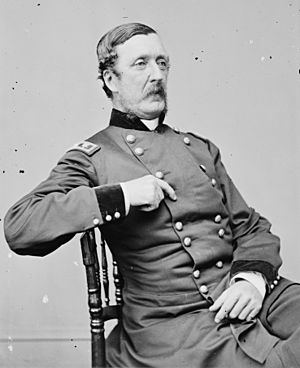William Farquhar Barry facts for kids
Quick facts for kids
William Farquhar Barry
|
|
|---|---|

William Farquhar Barry
|
|
| Born | August 18, 1818 New York City |
| Died | July 18, 1879 (aged 60) Baltimore, Maryland |
| Place of burial |
Forest Lawn Cemetery, Buffalo, New York
|
| Allegiance | United States of America Union |
| Service/ |
United States Army Union Army |
| Years of service | 1838–1879 |
| Rank | |
| Battles/wars | Mexican–American War Seminole Wars American Civil War |
William Farquhar Barry (born August 18, 1818 – died July 18, 1879) was an important officer in the United States Army. He was known for leading artillery units, which are groups that use large guns in battles. He served during the Mexican–American War and the American Civil War.
Early Life and Training
William Barry was born in New York City in 1818. He attended the United States Military Academy at West Point. This is a famous school for training army officers. He graduated in 1838, doing very well in his class.
After graduating, he became a second lieutenant. He joined the 4th U.S. Artillery. A few weeks later, he moved to the 2nd U.S. Artillery. He was stationed near the border between Canada and the U.S.
Barry also took part in several conflicts. These included the Mexican–American War and the Seminole Wars. He also served in the Kansas-Missouri Border Wars.
Military Career and Civil War
Barry helped write a book called Instruction for Field Artillery in 1860. This book was about how to use artillery in battles. He wrote it with William H. French and Henry Jackson Hunt.
When the American Civil War began, Barry was promoted to major. He was in charge of artillery for Brig. Gen. Irvin McDowell. This was during the First Battle of Bull Run. In that battle, his position was taken over by Confederate forces. He had mistaken them for his own retreating Union troops.
President Abraham Lincoln made Barry a brigadier general in August 1861. Barry also came up with an idea for a special group of artillery. This group became the U.S. Horse Artillery Brigade. It was part of the Army of the Potomac.
Later, Barry became the chief of artillery for Maj. Gen. George B. McClellan. He helped organize all the big guns for the Army of the Potomac. During the Peninsula Campaign, he fought in several battles. These included the Siege of Yorktown. He also fought at Mechanicsville and Gaines' Mill. Other battles were White Oak Swamp and Malvern Hill.
After this, Barry oversaw forts and weapons around Washington, D.C.. He then became the chief of artillery for Maj. Gen. William Tecumseh Sherman. He served with Sherman in Tennessee. He also joined Sherman during the famous Sherman's March to the Sea. And he was part of the Carolinas Campaign.
For his service in the Atlanta Campaign, Barry was recognized. He was given the honorary rank of major general in 1865. This was a special honor for his bravery and leadership.
After the Civil War
In 1865, Barry became a colonel in the 2nd U.S. Artillery. He was in charge of the northern border during the Fenian raids in 1866. These raids were by Irish-American groups. He stayed there until September 1867.
After that, he commanded an artillery training school. This school was at Fort Monroe. He led the school until March 1877. Then, he was given command of Fort McHenry in Baltimore, Maryland. During the labor riots of 1877, he helped keep order.
William Farquhar Barry died at Fort McHenry in 1879. He is buried at Forest Lawn Cemetery in Buffalo, New York.

